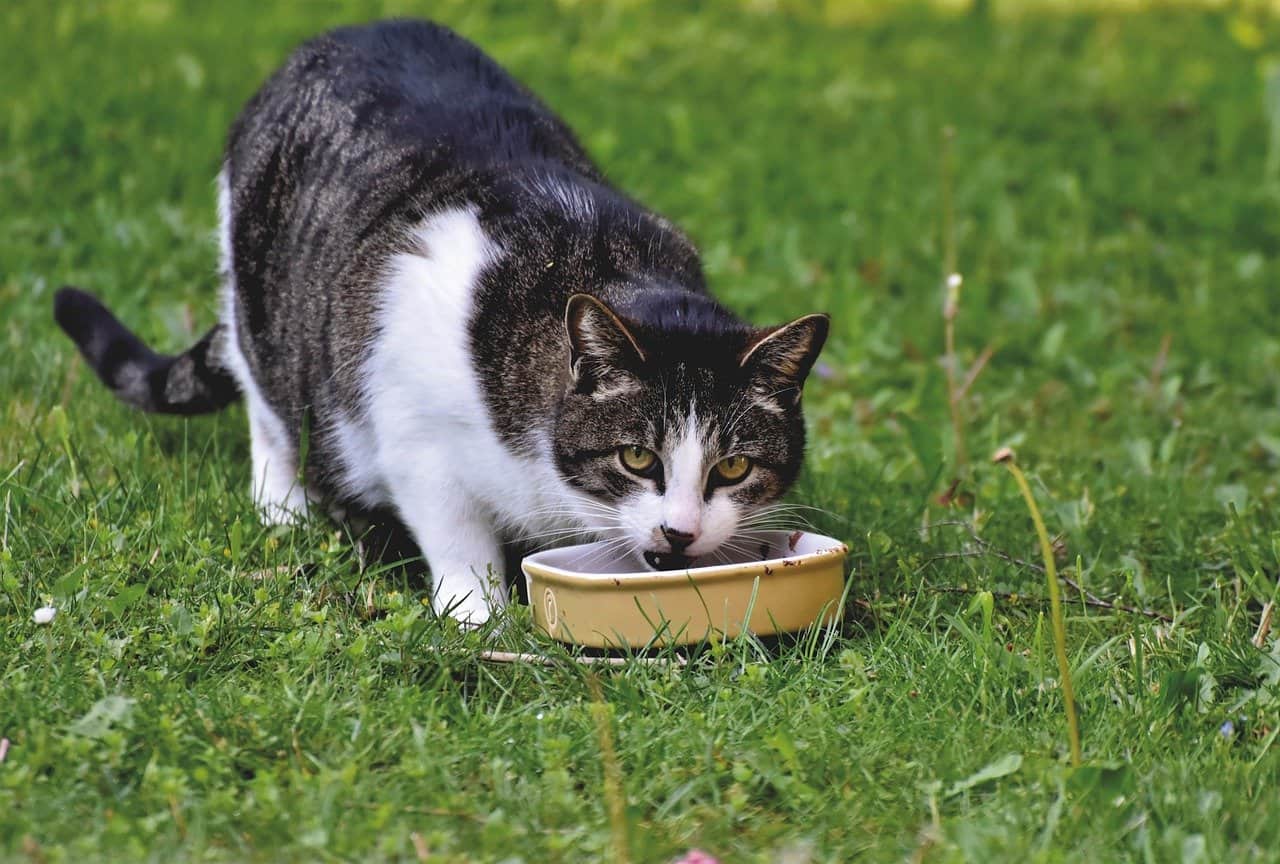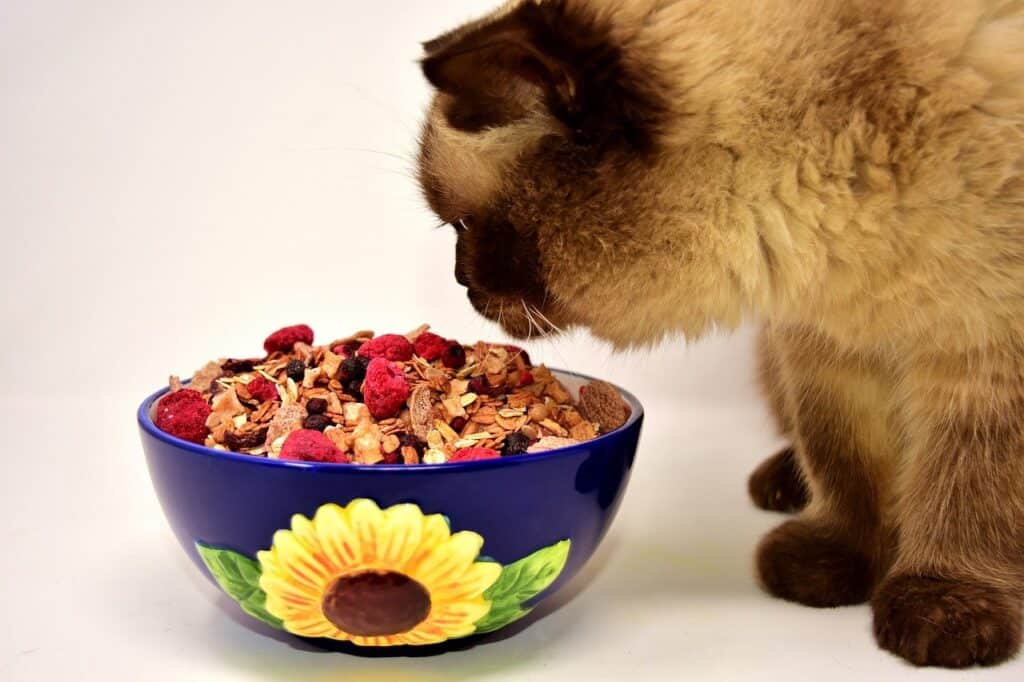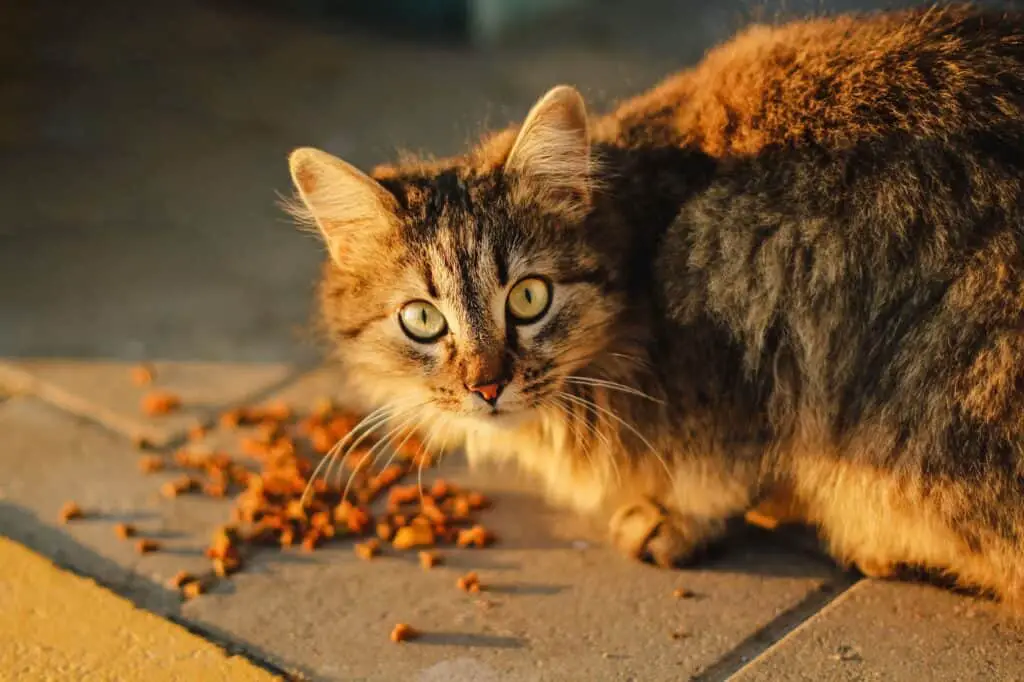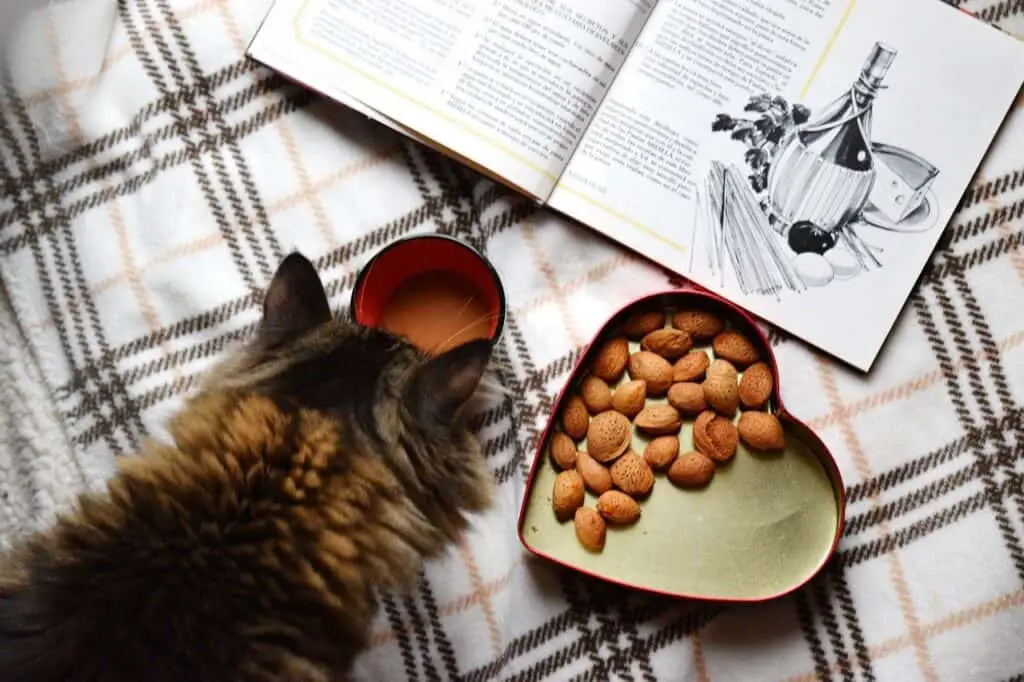Many of us adore our cats to the point where caring for one cat just isn’t enough. While having multiple cats in your home can increase their (and your) happiness, caring for them can become more complex.
When it comes to feeding, there are things to keep in mind when you have multiple cats. For example, can cats share food bowls?
Cats should not share food bowls because it can cause aggression and territorial behavior. Although some cats do share food, it is very rare and goes directly against their natural instincts. Sharing food bowls can also cause nutritional challenges and should be avoided.
While it is easier to feed all of your cats’ from the same bowl, there are several reasons why it isn’t a great idea.
Sharing food isn’t supportive of your cats’ health or happiness and can lead to an array of undesirable outcomes.
Why cats shouldn’t share food bowls
We, cat lovers, know how charming and personable they can be, and yet, they can become tempered quickly in certain scenarios. Cats are generally social creatures, and they enjoy the company of other cats in the home, but it is common for aggression and territorial behavior to arise when forced to share food.
Feline ancestry
Even though your feline may be domesticated within your household, all cats still have lingering genetic qualities. Cats are natural predators, and they would typically hunt for food throughout the day. This plays a large role in their eating preferences.
While feral cats may hunt in packs, this is generally out of convenience and efficiency.
In the wild, cats prefer to hunt alone and would not share with others because they are essentially competing for food sources.
As a result, your cat dislikes sharing food with other cats.
Aggression and territorial behavior
Cats can become quite territorial over their food. This is linked to their inherent genetics and ancestry.
When your cats share food bowls, they may fight over the food or try and keep other cats away from the area, known as ‘guarding’.
This can damage the relationships between your cats, which is not great for a happy and balanced living environment.
Additionally, this sort of situation leads to a sort of ‘natural selection’ effect. Your most dominant cat will probably get the most food, and your more timid cats suffer over time.
Cat’s can be very territorial when it comes to food. This is because in the wild they have to compete for food and this instinct still lingers in our domesticated cats.
Cats eat at their own pace
Cats enjoy the freedom to eat at the speed they’d like.
When sharing food bowls, they can feel pressured to overeat or eat much faster than they ideally would have.
They do this thinking they may not get food later if they don’t. These feeding habits are not constructive or enjoyable for them and disturb their calorie intake, digestion processes, and cause stress.
Cats like privacy
All cat owners can agree that while our fluffy felines love company and socialization, they appreciate their privacy when it’s needed.
In particular, cats treasure privacy when relieving themselves and when eating. Your cats would not enjoy eating while other cats are peering over their shoulders or occupying the immediate space.
What are the advantages of separate food bowls?
Although it may seem tedious or complex to provide each of your cats with separate food bowls, the benefits clearly outweigh any potential advantages of using one shared bowl.
Individual dietary requirements
Most cats require fairly similar diets, but a few breeds need specific nutrition plans or food sources.
Some cats need prescription diets or different food types depending on age and development stages.
Ensuring that your cat receives the nourishment needed can be challenging as it is. It will be impossible to track your cats’ nutritional intake when they share food bowls.
Portion sizes
While we can all agree that every cat eats in different amounts sporadically throughout the day, the total amount of food consumed differs between cats.
Depending on the age, breed, and activity level, each of your cats may require more or fewer calories than the others.
More active cats generally need more food for energy than cats that lounge for most of the day.
Similarly, younger cats need more food to encourage proper development as they grow. Giving each cat their own food bowl can help ensure each cat gets the amount of food needed for their daily activities.
Diet monitoring and changes
With fluctuating eating habits and numerous nutritional factors to consider, it can be challenging to monitor how much food your cat is eating.
We should be able to notice when our cats are not following standard feeding habits or are not finishing their food.
When cats share food bowls, gaining insight into abnormalities can be nearly impossible unless you closely observe them every time they eat.
This lack of awareness can make it hard to identify issues as they arise, potentially leading to a malnourished cat over time.
Cats also enjoy diversity in their diets, and you will likely need to try different food types or different feeding approaches at some point.
It’s far easier to make changes to individual eating habits over time if you can track their feeding routines.
Different favorite foods
Having separate food bowls for your cats can allow you to give them their favorites.
Depending on the breed or even personality, your cats may have a preference for certain flavors or textures.
Ensuring that each of your cats is given foods that they enjoy most will greatly enhance feeding experiences and ensure that all your cats feel equally loved and cared for.
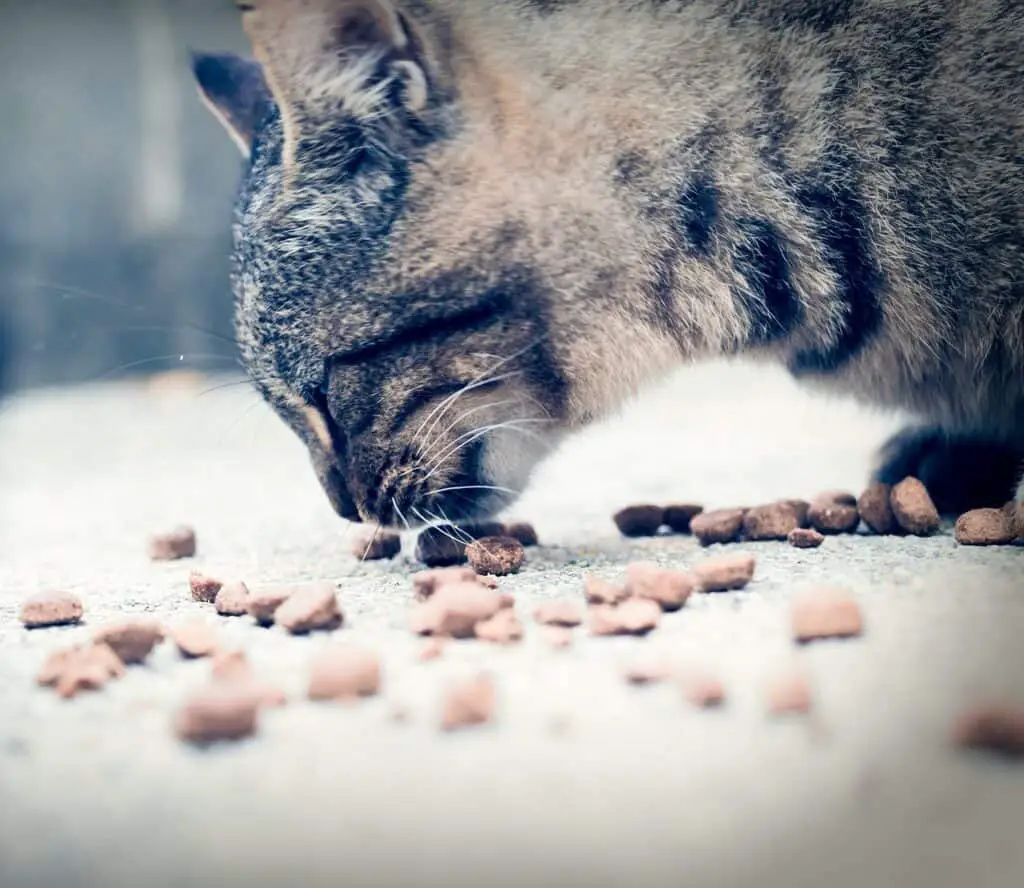
Why do some cats share food bowls?
Knowing that cats prefer not to share food, It can be fairly confusing to witness some cats sharing food bowls happily.
This behavior isn’t common, but it can happen sometimes depending on the relationship between your cats.
Some cats like to eat together because it can give them a sense of community or they may bond by eating together and sharing their food.
Some cats even take a nibble, use paws to gesture that the next cat can eat, the next cat would take a bite, gesture to the next cat, and the cycle would repeat until they’re all happy.
Older cats may also share food bowls to help younger cats learn the ins and outs of feline feeding habits.
It’s certainly sweet to observe this sort of behavior, and you can pat yourself on the back for raising well-mannered kitties. However, training them to eat from separate food bowls will be advantageous, as there are still some downfalls to this kind of feeding routine.
What’s the best way to feed multiple cats?
At this point, you may be wondering how complex it would be to provide good feeding environments to all your cherished cats. Nevertheless, it can be quite straightforward when taking into account a few basic things.
How many food bowls should be provided?
If you own many cats, you can essentially have as many food bowls as you feel necessary, depending on how many cats you have and how much space you have in your home.
Each of your cats can be given one individual food bowl, but some owners like to have multiple food bowls per cat for larger properties such as farms. The main factor is that your cats know which bowl belongs to them.
Placement
The placement of the food bowls will also play a role in how your cats behave around feeding times.
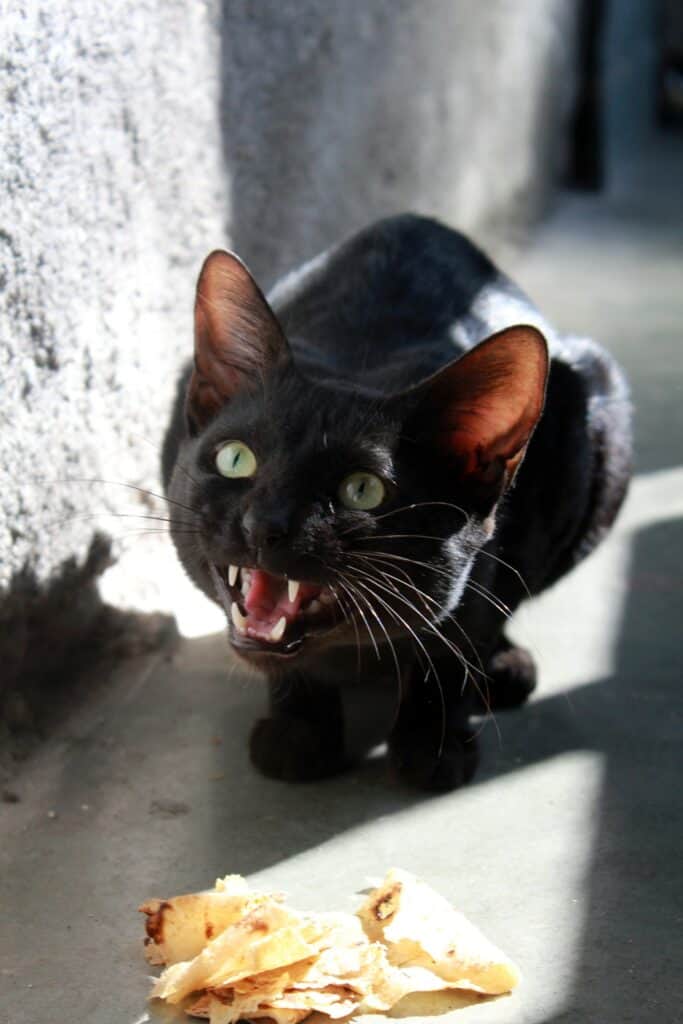
Although you may create a healthy and happy communal feeding space for your cats with training, placing all food bowls together can cause some issues such as territorial behavior or general aggression.
If one or more of your cats are dominant and more territorial than others, they may fight with other cats concerning which bowl belongs to who.
Some cats are known to change their minds periodically, which can cause a lot of confusion for your cats during mealtimes and yourself when serving foods.
It’s always best to make sure each cat’s food bowl is placed in different areas. Different rooms are best but, if not possible, you should at least go for different corners.
Separating the food bowls will help your cats get comfortable with which food bowl is theirs and help you make sure each cat gets the right food.
Creating such a feeding space will also alleviate any discomforts your cats may have with privacy and space while eating. This will allow each cat to eat when they feel inclined and eat at their own pace.
Additionally, it is a good practice to slightly elevate your cat’s food bowl. It’s more comfortable for your cat to eat when not having to bend its neck all the way down. t It is also advantageous for your cat’s digestion.
For our cat, Max, we use this simple but effective elevated stand and he loves it.
Can cats share water bowls?
As a general rule, cats can share water bowls without issues. In the wild, they also share water sources without territorial behavior. Water is more abundant than food and because cats drink small amounts at a time, there is less competition over water.
Additionally, cats get most of their water intake from (wet) food, therefore they don’t need to drink as much.
In your home, however, it’s still best to have multiple water bowls place at different spots in the house. This will help to monitor each cat’s water intake and provide multiple opportunities for them to drink.
Interchangeable Sharing
Cats drink much quicker than they eat, and it’s more convenient for them to share water. A water bowl can typically hold far more water than they would drink within a few hours, meaning there is usually more than enough to go around.
Having multiple water bowls throughout your home can support proper hydration for all your cats, even if they share them interchangeably.
Not all cats like sharing water bowls
While many cats do not mind sharing water bowls, this may not be the case for your cats. In some situations, your cats may still become territorial over their water which can cause aggression and fighting.
Such cases may lead to one or more of your cats being dehydrated since they may not drink as much water as they ideally should.
Shared water fountains
If setting out numerous water bowls is not practical, a water fountain may be a good option.
Water fountains are relatively affordable and only need an electrical outlet. They provide fresh flowing water for your cats and would be an excellent option for a shared water source.
Cats also prefer drinking flowing water because they perceive it as more fresh and clean.
What are the best cat-feeding bowls?
It can be tempting to grab the cheapest or prettiest food bowls you find. But, a few considerations need to be taken to ensure your cats can enjoy their meals.
Thankfully, many well-designed cat food bowls are still reasonably affordable and easy to get your hands on.
Cat food bowl designs
When selecting a fantastic food bowl for each of your beloved felines, the main area of consideration is the shape and size.
Cat food bowls should be wide and shallow with a smaller edge. This shape supports how they feed as it spreads food out evenly and lowers the risk of their whiskers constantly touching the edges, causing “whisker fatigue”.
Cat food bowl material
There are many non-toxic materials that cat food bowls can be made from, and you can certainly choose any of these bowls.
However, stainless steel is considered the best material for cat food bowls for hygiene and health reasons. They are easy to clean properly and are typically tested to be free of harmful substances, depending on the manufacturer.
Our sponsor Chewy offers a wide range of stainless steel feeding bowls for cats. Have a look at them here.
Final thoughts
Cats usually prefer to eat alone, as they enjoy the privacy and freedom that accompanies this sort of feeding environment.
Even if your cats love to eat together, try encouraging them to eat from individual bowls over time. Providing separate bowls will make it far simpler to ensure the health and happiness of each of your precious and endearing feline companions throughout the course of their lives.
What about sharing our menu with our cat? Can you eat food that has been touched by your cat? See our opinion about it here: “Can you eat food licked by your cat?“

